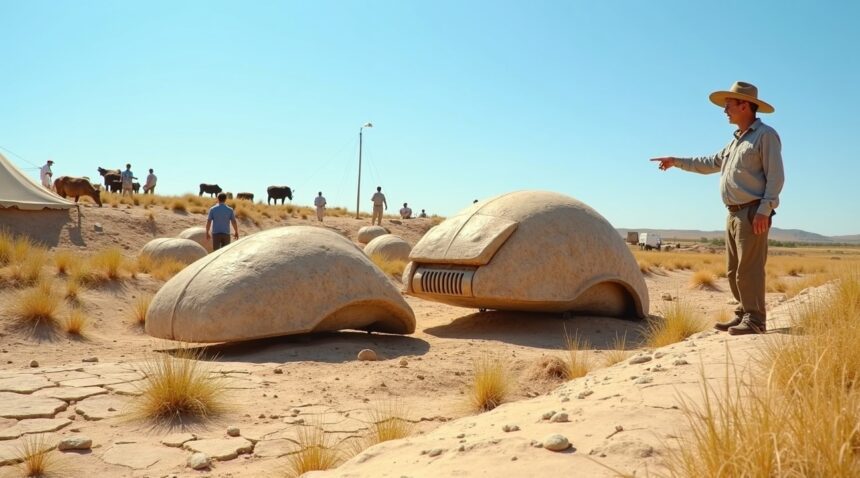A farmer in Argentina’s Buenos Aires province made an extraordinary discovery when severe drought conditions exposed four massive fossilized shells belonging to Glyptodonts, prehistoric giant armadillos that lived during the Pleistocene epoch.
These car-sized specimens, weighing up to 1,000 kilograms each, represent one of the most significant paleontological finds in recent years. The discovery offers unprecedented insights into ancient megafauna that once roamed South America until their extinction approximately 10,000 years ago.
Key Takeaways
- Multiple Specimens Unearthed: Four complete Glyptodont shells were discovered by farmer Juan de Dios Sota in a dried riverbed, representing a rare instance of multiple specimens found together.
- Massive Size and Weight: Each fossilized shell measures approximately the size of a small car and weighs around 500 kilograms, showcasing the tremendous scale of these prehistoric armadillos.
- Family Group Preserved: The find appears to consist of a family group with two adults and two juveniles, providing scientists with rare opportunities to study Glyptodont social behavior and sexual dimorphism.
- Ancient Survivors: Glyptodonts thrived for nearly 20 million years before becoming extinct around 10,000 years ago, a period that coincides with drastic climate changes and the arrival of early humans in South America.
- Unique Defensive Traits: These ancient giants were protected by impenetrable armor made of fused bone plates but had a notable weakness—if flipped onto their backs, they became highly vulnerable, a trait early human hunters likely exploited.
The discovery has attracted the attention of scientists worldwide and is expected to enrich the understanding of the ecosystems and evolutionary traits of Pleistocene-era mammals. For further insights into Glyptodonts and their paleontological significance, visit the Glyptodont Wikipedia page.
Car-Sized Fossil Shells Unearthed by Argentine Farmer During Drought
A remarkable discovery unfolded in Buenos Aires province when farmer Juan de Dios Sota stumbled upon four massive fossilized shells while tending to his cattle during a severe drought. The extraordinary find occurred as he guided his livestock to graze near a dried riverbed, where receding waters had exposed ancient treasures hidden for thousands of years.
Discovery Details and Location
The drought conditions that plagued the region proved beneficial for paleontological science, as the lack of water revealed what had been concealed beneath the riverbed for millennia. Sota noticed unusual protrusions emerging from the exposed ground and realized he’d encountered something significant. These weren’t ordinary rocks or debris — they were the preserved remains of Glyptodonts, ancient giant armadillos that roamed South America during the Pleistocene epoch.
Each shell measured approximately the size of a small car, demonstrating the incredible scale of these prehistoric creatures. The discovery site in Buenos Aires province has become a focal point for researchers studying ancient South American megafauna. Drought conditions, while challenging for agriculture, often create opportunities for such paleontological discoveries by exposing previously buried specimens.
Understanding Glyptodonts and Their Massive Shells
Glyptodonts represented some of the most impressive armored mammals that ever existed, dwarfing their modern armadillo relatives by an enormous margin. These prehistoric giants possessed shells constructed from hundreds of individual bony plates called osteoderms, which fused together to create nearly impenetrable armor. The shells discovered by Sota showcase the remarkable preservation potential of these dense, calcified structures.
The massive size of these creatures reflected the unique evolutionary conditions of Pleistocene South America, where megafauna flourished until relatively recent times. Unlike modern armadillos that can roll into balls for protection, Glyptodonts relied on their sheer size and armor thickness for defense against predators. Their shells could withstand tremendous forces, which explains why they’ve survived the fossilization process so effectively.
Scientists find particular value in studying these specimens because they provide insights into ancient ecosystems and climate conditions. The discovery adds to our understanding of how these creatures lived and interacted with their environment, including early human populations who arrived in South America. These prehistoric giants went extinct around 10,000 years ago, coinciding with significant climate changes and human expansion across the continent.
The preservation quality of Sota’s discovery allows researchers to examine shell structure, growth patterns, and even potential evidence of ancient injuries or diseases. Such comprehensive specimens are relatively rare, making this find particularly valuable for scientific study. The shells may contain microscopic details that reveal information about the creatures’ diet, habitat preferences, and seasonal behaviors.
Modern technology enables scientists to extract far more information from these fossils than previous generations could imagine. CT scanning, chemical analysis, and advanced imaging techniques help reconstruct how these animals moved, fed, and survived in their ancient environment. Each shell serves as a time capsule, preserving details about life on Earth during a period when massive creatures dominated the landscape.
The farmer’s discovery highlights how citizen science and chance encounters continue to contribute significantly to paleontological research. Sota’s keen observation and decision to report his find ensures these specimens will contribute to scientific knowledge rather than remaining hidden or damaged. His discovery demonstrates that some of the most important prehistoric discoveries still happen through serendipitous encounters rather than planned excavations.
This find reinforces Argentina’s position as one of the world’s premier locations for prehistoric discoveries, particularly megafauna specimens. The country’s geological conditions and climate history have created ideal preservation environments for ancient remains, making it a hotspot for paleontological research. Each new discovery adds pieces to the puzzle of understanding how ancient ecosystems functioned and why certain species thrived while others disappeared.
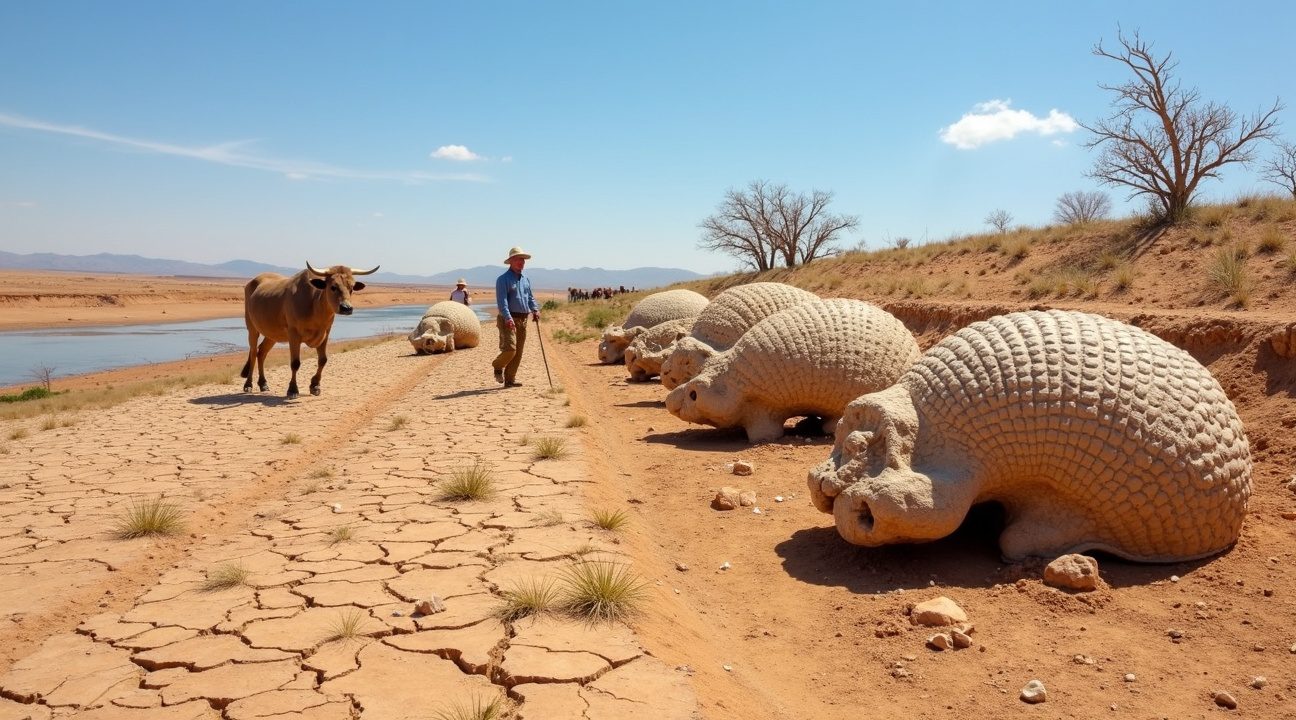
Meet the Glyptodont: A Volkswagen Beetle-Sized Armadillo
I find it fascinating that nature once produced armadillos the size of small cars. Glyptodonts represent one of the most impressive examples of prehistoric megafauna, dwarfing their modern relatives in both size and defensive capabilities. These ancient mammals shared ancestry with today’s armadillos but evolved into something far more massive and formidable.
The sheer scale of these creatures defies imagination. The largest recovered glyptodont shells measure up to 3 meters in length – roughly 10 feet from nose to tail. Picture a Volkswagen Beetle, and you’ll have an accurate mental image of these prehistoric giants. Their total body weight exceeded 1,000 kilograms, making them heavier than most modern cars at approximately 2,200 pounds.
What strikes me most about glyptodonts is the incredible engineering of their protective shells. These bony carapaces alone could weigh up to 500 kilograms – that’s 1,100 pounds of pure defensive armor representing about 20% of the animal’s total body mass. Unlike modern armadillos with their flexible, segmented shells, glyptodonts carried rigid domes that couldn’t fold or contract. This solid construction provided maximum protection but came at the cost of mobility and flexibility.
Evolutionary Timeline and Extinction
The glyptodont lineage spans an impressive temporal range that showcases the patience of evolutionary processes. These remarkable creatures first appeared approximately 20 million years ago during the Miocene epoch. Their development represents a fascinating example of how environmental pressures can drive species toward gigantism over millions of years.
For nearly 20 million years, glyptodonts thrived across South America, adapting to various climates and ecosystems. They witnessed continental drift, climate changes, and the rise and fall of countless other species. However, their remarkable evolutionary success story came to an end around 10,000 years ago at the close of the last Ice Age.
The timing of their extinction coincides with significant environmental changes and the arrival of human populations in South America. Climate shifts dramatically altered their habitat, while early human hunters may have contributed additional pressure on these slow-moving giants. Similar to discoveries of prehistoric fossil sites, glyptodont remains provide crucial insights into how ancient ecosystems functioned and why certain species survived while others vanished.
Their extinction represents part of a larger pattern of megafaunal die-offs that occurred worldwide as the Pleistocene epoch ended. Massive mammals across continents – from woolly mammoths to giant ground sloths – disappeared during this same period, fundamentally reshaping the animal kingdom we recognize today.
The discovery of complete glyptodont shells continues to amaze paleontologists and the public alike. These finds offer rare glimpses into a time when South America hosted an array of supersized creatures that would seem mythical if we didn’t have fossil evidence. Each shell tells a story of survival strategies, environmental adaptation, and the constant evolutionary arms race between predators and prey.
Modern armadillos, despite their relatively small size, carry the genetic legacy of these ancient giants. They represent the successful downsizing of the glyptodont body plan – trading massive defensive shells for increased mobility and metabolic efficiency. This evolutionary trajectory demonstrates how survival sometimes requires abandoning previous advantages in favor of new strategies better suited to changing conditions.
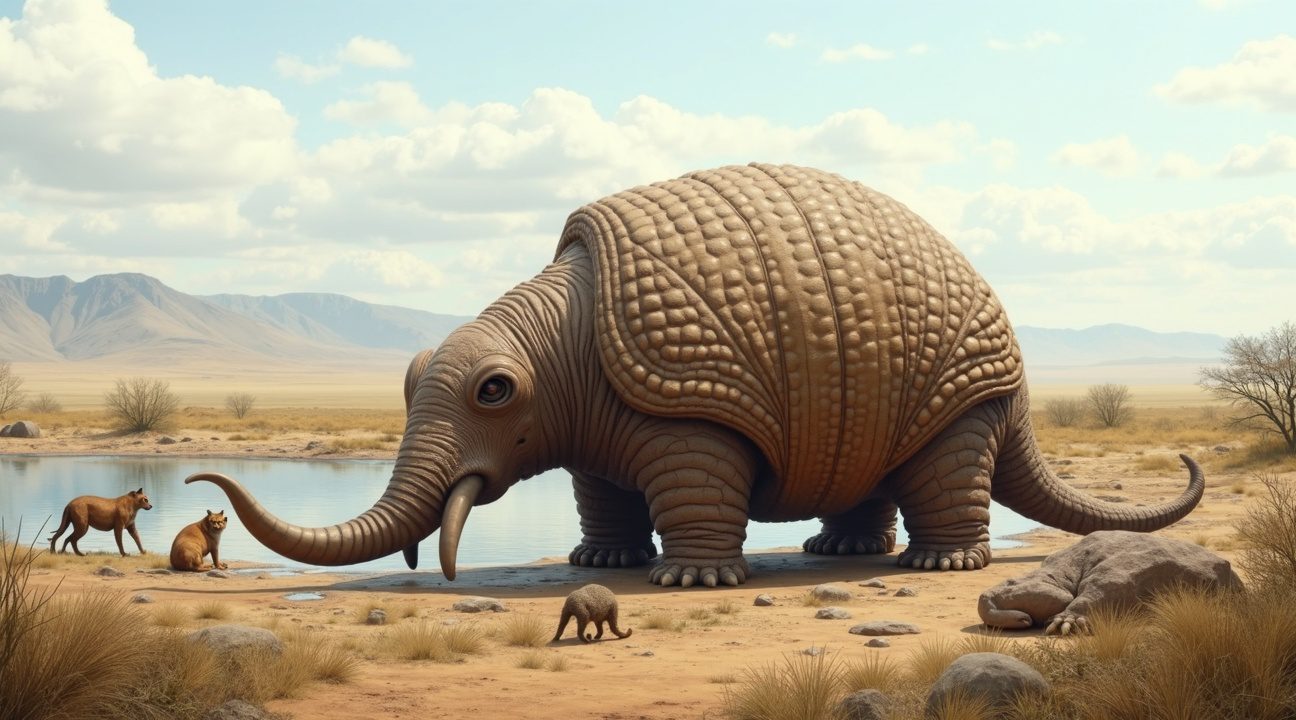
Why This Discovery Has Scientists Excited
Finding four Glyptodont individuals together represents an extraordinary breakthrough that has paleontologists buzzing with anticipation. Such groupings are exceptionally rare in the fossil record, making this Argentine discovery a scientific goldmine that could reshape understanding of these ancient armored giants.
Unprecedented Social Behavior Insights
The discovery allows researchers to investigate previously unknown aspects of Glyptodont social behavior. Scientists believe the group consists of two adults and two juveniles, potentially of different sexes, creating a unique opportunity to study family dynamics that existed millions of years ago. This family unit structure suggests these massive creatures may have lived in social groups rather than as solitary animals, challenging long-held assumptions about their lifestyle.
The potential for studying sexual dimorphism adds another layer of excitement to this find. Researchers can now examine physical differences between male and female Glyptodonts, information that’s been nearly impossible to gather from isolated specimens. These size and structural variations could reveal how these prehistoric giants adapted their social roles and survival strategies.
Revolutionary Research Opportunities
Paleontologists from the Institute of Archaeological and Palaeontological Investigations of the Pampa Quaternary (INIPQUA/INCUAPA-CONICET) are overseeing this crucial excavation and study. Their expertise ensures that every detail is carefully documented and analyzed, maximizing the scientific value of this rare find.
The developmental aspects revealed by having both adults and juveniles together offer insights into growth patterns and maturation processes. Scientists can study how these car-sized shells developed from smaller juvenile forms, understanding the timeline and physical changes that occurred as these creatures aged. This information connects to broader questions about prehistoric evolution and adaptation.
Modern technology allows researchers to examine these specimens in ways that weren’t possible during previous discoveries. Advanced imaging techniques can reveal internal structures, feeding habits, and even potential cause of death for this ancient family group. Each shell tells a story that extends far beyond individual anatomy.
This discovery also contributes to understanding prehistoric ecosystems and environmental conditions. The preservation of multiple individuals suggests specific circumstances that allowed for their simultaneous burial and fossilization, providing clues about ancient climate events or geological processes.
The rarity of finding multiple Glyptodont specimens together makes this discovery particularly valuable for comparative studies. Researchers can now examine variations within the same species and potentially identify new subspecies or evolutionary adaptations that weren’t apparent from single specimens. Such findings could influence how scientists approach fossil preservation studies and excavation strategies in similar geological formations across South America.
Life as an Ice Age Giant
I find it fascinating that Glyptodonts weren’t just oversized armadillos wandering around prehistoric South America – they were ecological powerhouses that shaped their entire environment. These herbivorous giants spent their days grazing on grasses, shrubs, and other vegetation, moving through the landscape like living tanks while maintaining the delicate balance of Ice Age ecosystems.
Armor-Plated Defense Systems
The Glyptodont’s most striking feature was its incredible defensive armor, constructed from fused bone plates called osteoderms. Unlike modern armadillos that can roll into balls, these massive creatures couldn’t curl up for protection. Instead, they relied on their permanent fortress of bone, which covered nearly their entire body like a custom-fitted dome. This shell wasn’t just thick – it was strategically designed with overlapping plates that could absorb tremendous impact while allowing some flexibility for movement.
Their heads weren’t left vulnerable either. Glyptodonts developed heavily armored skulls and even their tails became weapons, often ending in spiked clubs that could deliver devastating blows to any predator brave enough to attack. I can imagine these creatures using their tail clubs much like medieval maces, swinging them with surprising accuracy despite their bulk.
Early Human Encounters and Hunting Strategies
Archaeological evidence suggests that early humans discovered a clever weakness in the Glyptodont’s otherwise impenetrable defense system. While the shell provided excellent protection from above and the sides, the underside remained relatively soft and vulnerable. Researchers believe ancient hunters developed techniques to flip these giants onto their backs, exposing their bellies for a killing blow.
This hunting strategy required incredible cooperation and planning. Consider the logistics – a full-grown Glyptodont could weigh as much as a small car, making the task of overturning one a community effort. Early humans likely used a combination of techniques:
- Coordinated attacks with multiple hunters working together
- Strategic use of terrain features like cliffs or slopes
- Possible use of ropes or leverage tools to assist in the flipping process
- Timing attacks when Glyptodonts were near water sources or feeding
The discovery of Glyptodont shells with human-made modifications supports this theory. Some shells show evidence of being converted into shelters, suggesting these early hunters didn’t waste any part of their massive prey. I think it’s remarkable how prehistoric sites reveal such detailed information about these ancient interactions between humans and megafauna.
These hunting practices may have contributed to the Glyptodont’s extinction around 10,000 years ago, though climate change at the end of the Ice Age played a significant role as well. The combination of human pressure and shifting environmental conditions proved too much for these armored giants to survive.
Living as a Glyptodont meant existing in a constant state of readiness. While their armor provided security, it also limited their speed and agility. They couldn’t flee from danger like other herbivores, so they had to rely entirely on their defensive capabilities and the deterrent effect of their massive size. This lifestyle worked successfully for millions of years until the arrival of human hunters who could think strategically about exploiting their weaknesses.
The Glyptodont’s story reminds me that even the most well-defended creatures can be vulnerable to new threats they haven’t evolved to handle. Their impressive shells, which had protected them from saber-toothed cats and other predators for eons, couldn’t adapt quickly enough to counter human intelligence and cooperation. This pattern would repeat itself throughout history as environmental changes reveal how species adapted to past challenges but struggled with new ones.
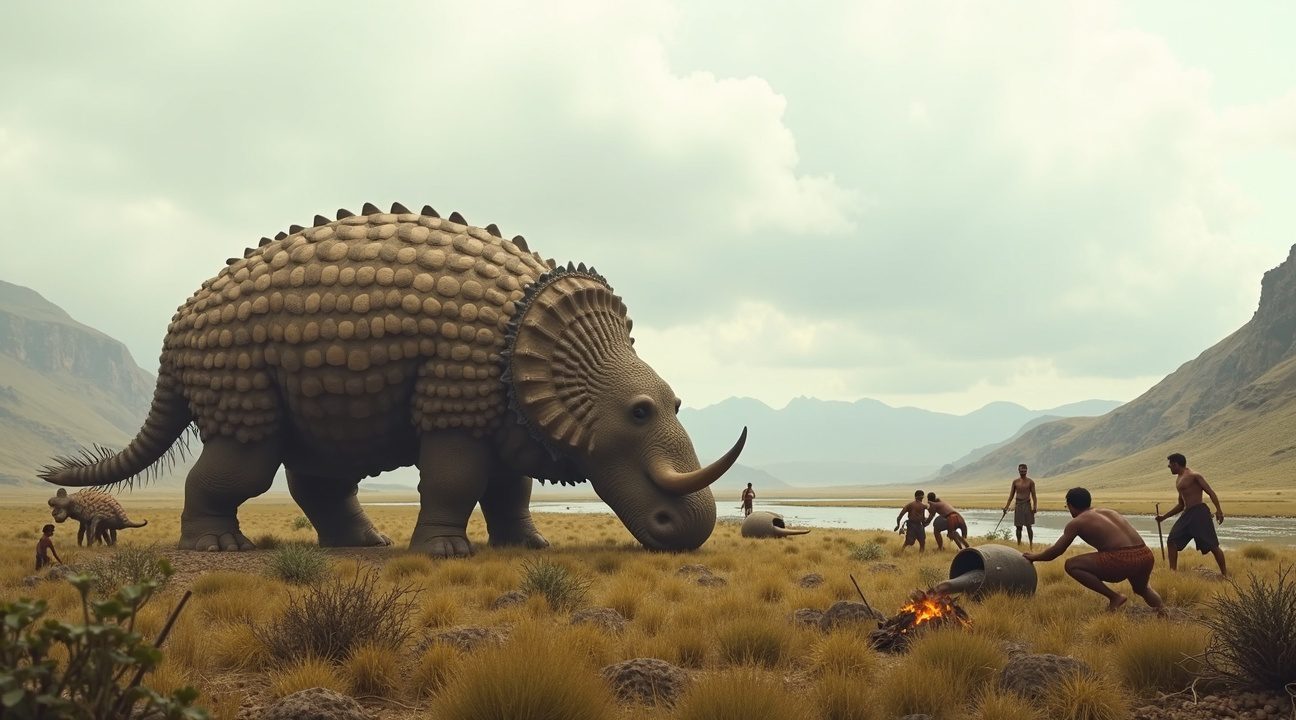
How Glyptodonts Compare to Modern Armadillos and Cars
The size difference between glyptodonts and their modern relatives creates a truly staggering comparison that helps put these prehistoric giants into perspective. When I examine the measurements, glyptodonts reached lengths of up to 3 meters (10 feet), making them six to ten times larger than today’s armadillos, which typically measure between 0.3 to 1.5 meters (1-5 feet).
Weight and Shell Comparisons
The weight differences reveal even more dramatic contrasts. Glyptodonts tipped the scales at around 1,000 kg (2,200 lbs), while modern armadillos weigh a modest 5–54 kg (11–119 lbs). That means a single glyptodont weighed as much as 18 to 200 modern armadillos combined. The shell alone accounted for approximately 500 kg (1,100 lbs) of their total weight, compared to the 2–5 kg (4–11 lbs) shells that protect today’s armadillos.
These prehistoric creatures actually outweighed many modern vehicles. A glyptodont’s 1,000 kg frame exceeded the approximately 800 kg (1,764 lbs) weight of a Volkswagen Beetle, making them heavier than one of history’s most popular compact cars.
Putting Size into Visual Context
Size comparisons become clearer when I consider common reference points that people encounter daily. While a Volkswagen Beetle measures approximately 4 meters (13 feet) in length, glyptodonts weren’t far behind at 3 meters, making them roughly three-quarters the length of this classic car. Picture a compact vehicle, then imagine an armored creature nearly matching its footprint — that’s the scale of these ancient giants.
Modern armadillo shells provide protection that’s remarkable for their size, but glyptodont shells operated on an entirely different level. The 500 kg shell weight represents more than 100 times the protective armor carried by today’s largest armadillos. This massive defensive structure required corresponding muscle development and skeletal support that fundamentally shaped how these creatures moved and lived.
The visual impact of encountering a glyptodont would have been extraordinary. Standing next to one would feel similar to approaching a small car, except this “vehicle” was a living, breathing creature with a dome-shaped shell that could deflect predator attacks. Prehistoric site discoveries continue to reveal how these impressive dimensions allowed glyptodonts to dominate their ancient ecosystems through sheer physical presence rather than speed or agility.
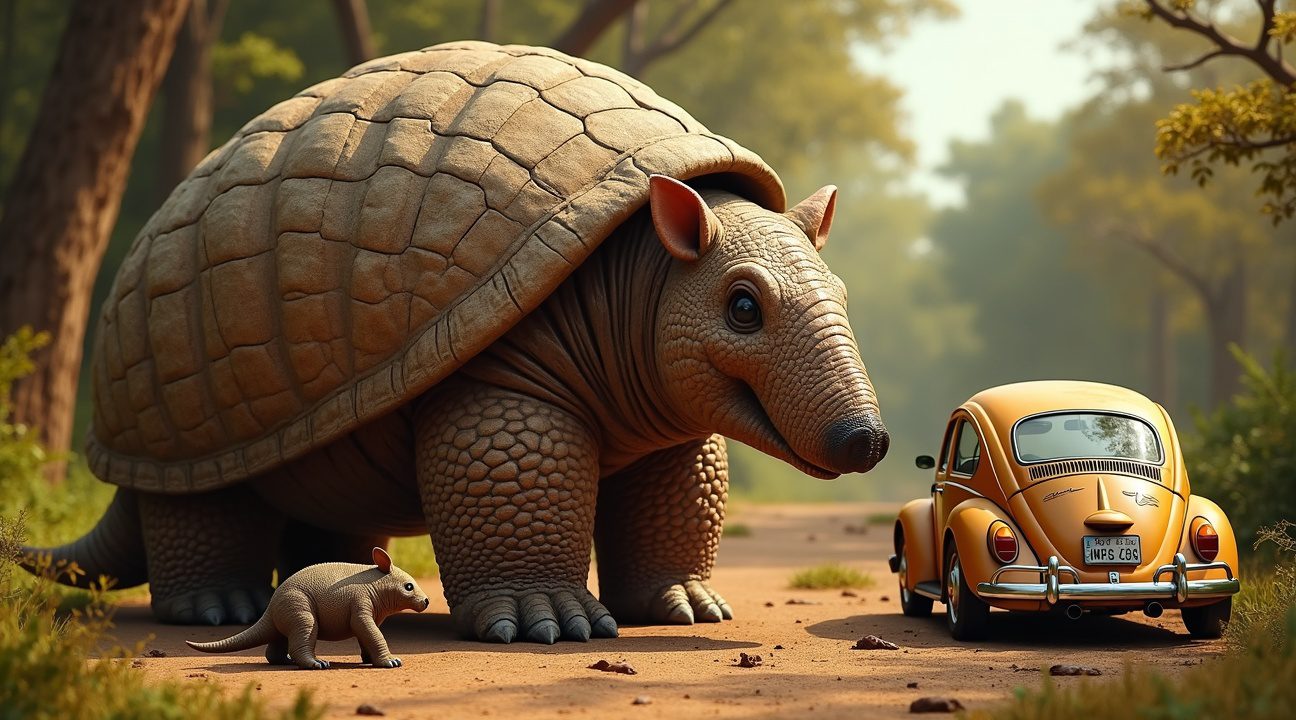
Sources:
Geology In – Ancient Giant Armadillo The Size of A Car Discovered In Argentina
IFLScience – Ancient Armadillos The Size Of A Small Car Discovered In Argentina
Natural History Museum, London – Giant glyptodont armadillos may have been hunted by early South Americans
All That’s Interesting – Argentinian Farmer Finds Four Fossilized Ancient Armadillos

